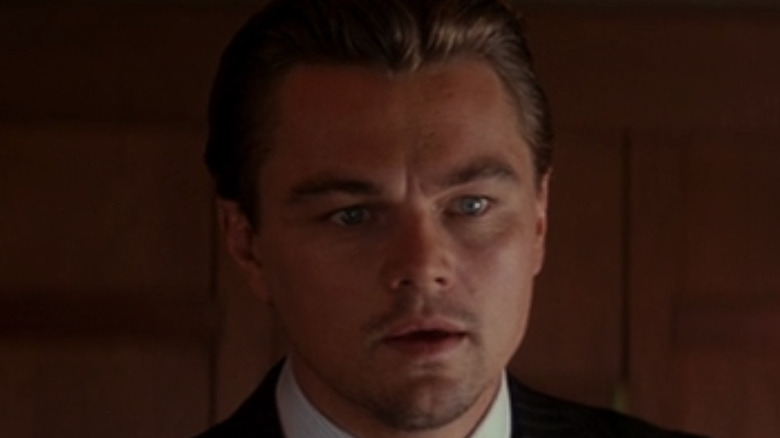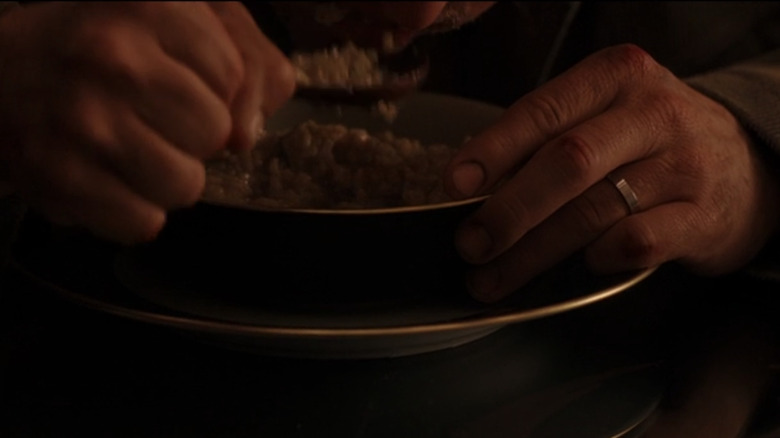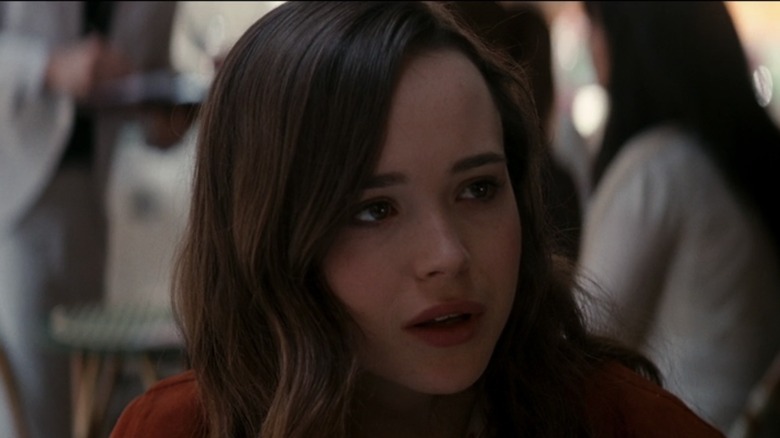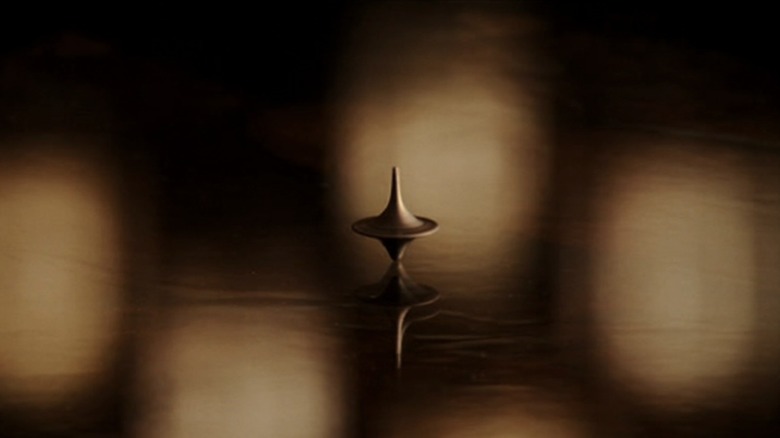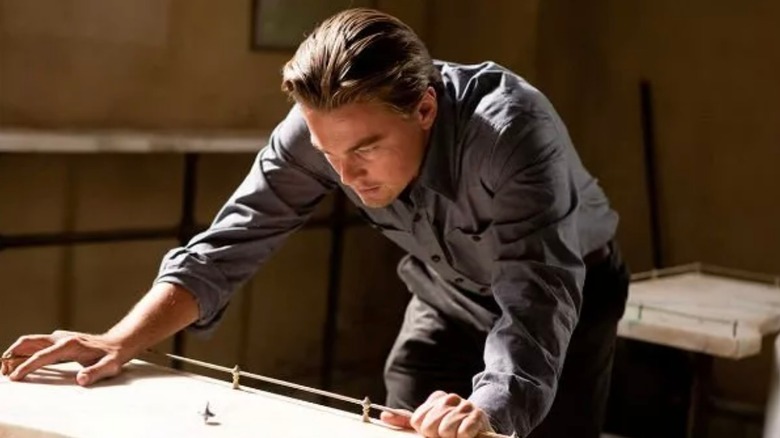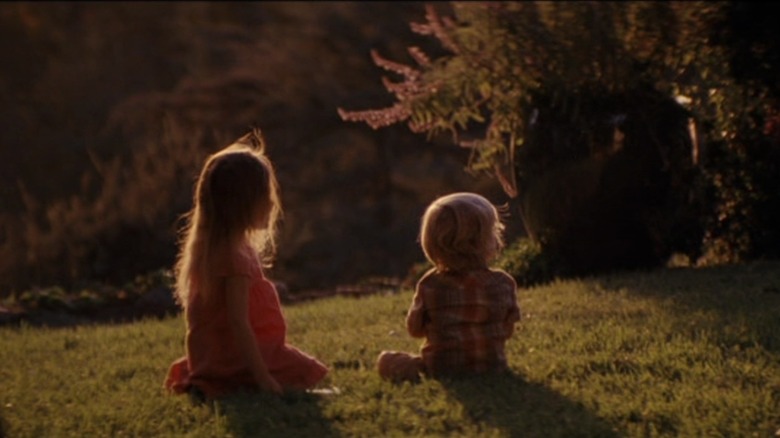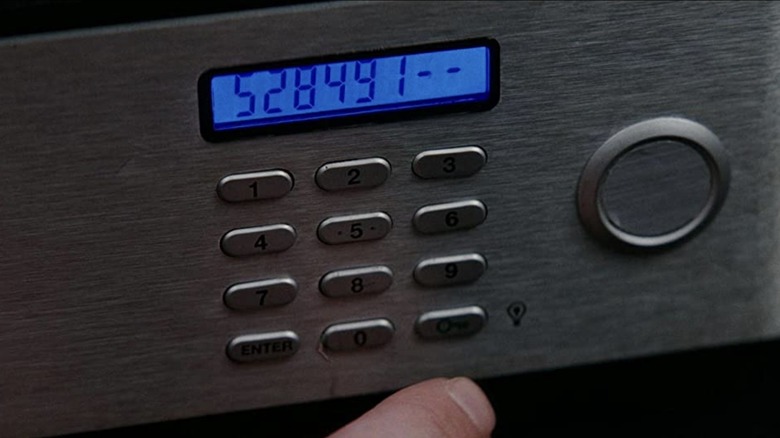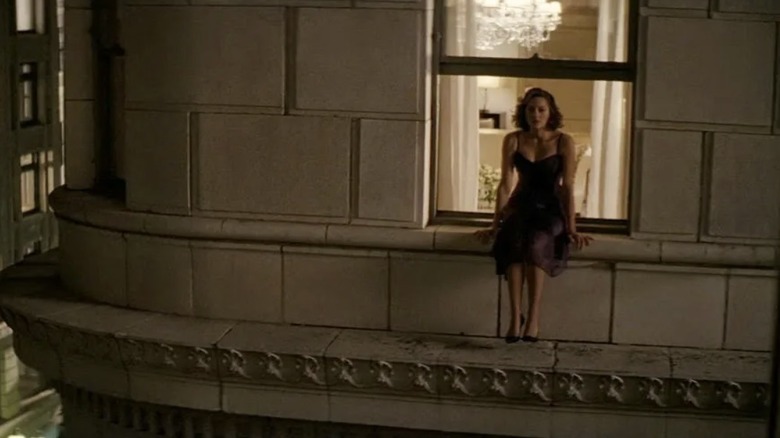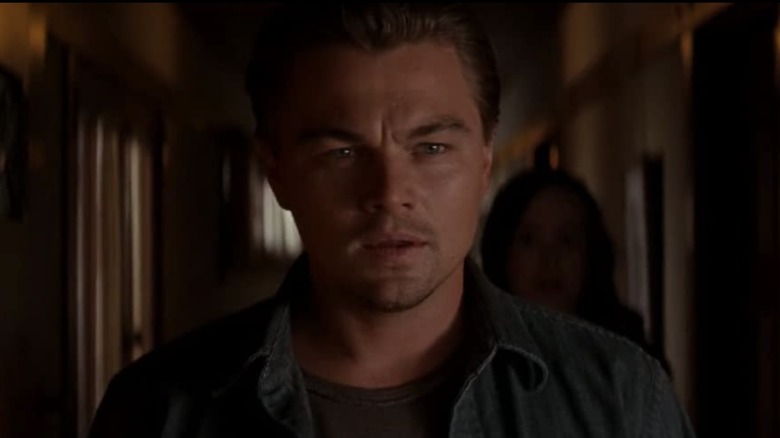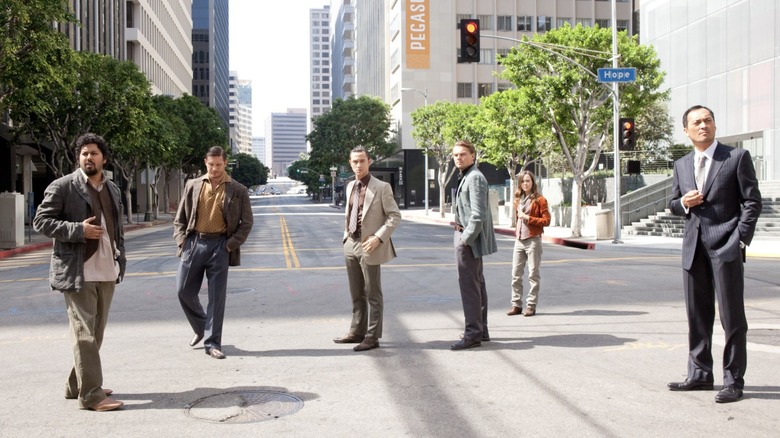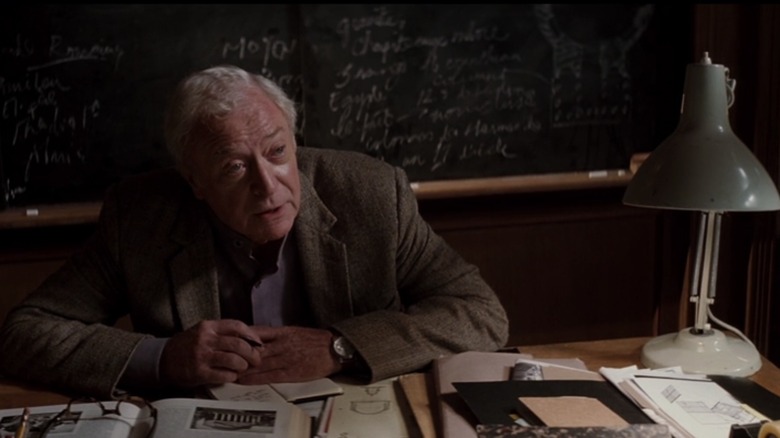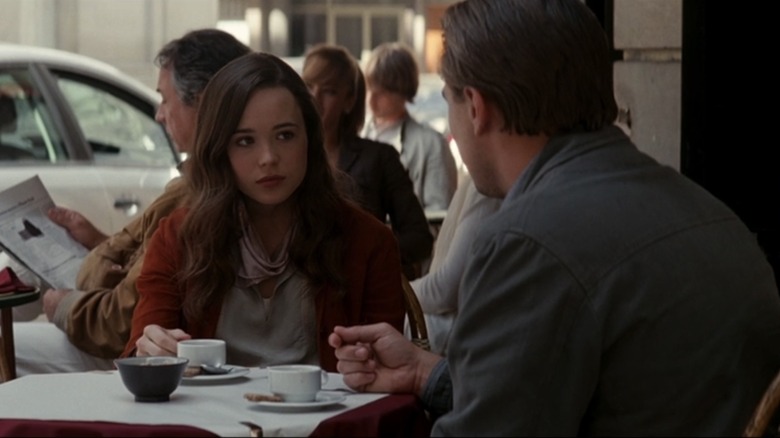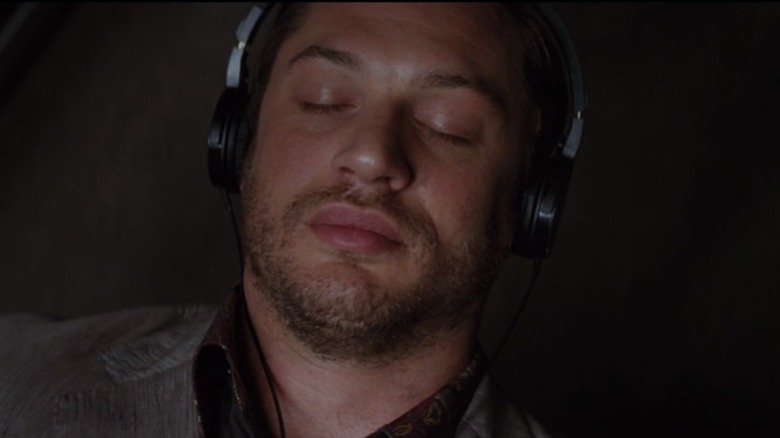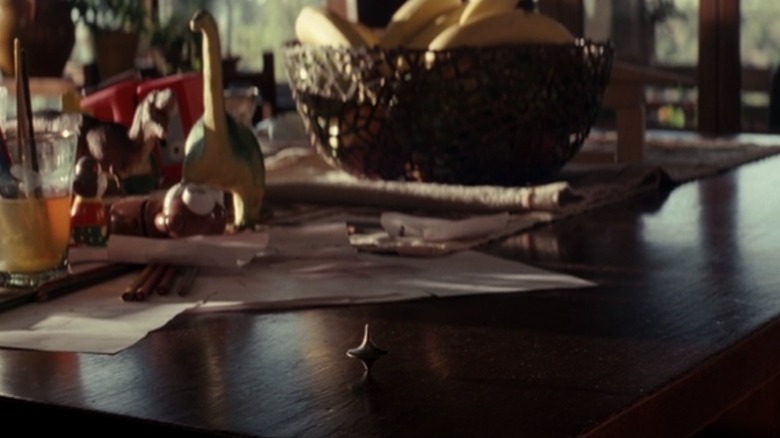Things You Only Notice About Inception After Watching It More Than Once
Christopher Nolan's film "Inception" is absolutely mind-bending, which is something we've expected of him since he hit us with "Memento" back in 2000. The film centers on Dom Cobb (Leonardo DiCaprio), a man with a very special skill set — infiltrating a target's mind using dream-sharing technology and extracting trade secrets while they're in a dream state. But Saito (Ken Watanabe), the CEO of an energy conglomerate, approaches Dom and his partner Arthur (Joseph Gordon-Levitt) about accomplishing the inverse — inception, when an idea is implanted in a competitor's mind.
This isn't the type of job Dom and Arthur typically take because most think inception isn't possible. But when Saito offers to clear Dom's name, giving him a chance to go home to his children, Cobb agrees to the job and assembles a dream team. As Cobb and his crew descend through multiple levels of dream states, various clues hint at the truth behind "Inception."
Critics and fans have hotly debated the ending since we first watched the screen cut to black after Cobb is reunited with his children and the top continues spinning. The ending has fans arguing about whether Cobb is trapped in a dream or found his way back to reality. Some have searched the film for clues to Cobb's reality, and true to form, Nolan has packed the film with hints and details you may have missed during the first screening. Join us as we explore some details you only notice after viewing the film multiple times.
Dom Cobb's wedding ring
In the first scene of "Inception," Cobb washes ashore and is taken by private security to an elaborate house on the cliffs above. As the host — a very old man (Saito) — speaks, the camera focuses on Cobb's hands while he eats from a bowl, pausing on his wedding ring. This ring isn't always on Cobb's hand, leading to some interesting fan theories about its significance and link to the dream state.
Some argue that since Cobb told Ariadne he and Mal (Marion Cotillard) are still together in his dreams, Cobb only wears his ring in the dream world, and a careful viewing of the film does suggest this is an indicator of reality for the audience. As discussed by Den of Geek, some fan theories even suggest Cobb's totem (an object used to verify reality) is actually his wedding ring and not the spinning top that once belonged to his dead wife, Mal. Still, others refute the ring theory, and there are multiple Reddit threads arguing for and against it.
If you watch Cobb's hand for the entirety of the film, many believe you can ascertain when he is in a dream state and when he is awake, leading fans of this theory to believe Cobb is awake when he goes home to his children at the end of the film. We can see he is not wearing a wedding ring after the flight attendant hands Cobb immigration papers on the plane and while he is entering the country. The inconsistency of Cobb's wedding ring's presence probably isn't something you noticed the first time you watched the movie, but if you pay attention to the ring in subsequent viewings, it is a persuasive argument for Cobb reuniting with his children.
The significance of Ariadne's name
If you're a Greek mythology enthusiast, you probably noticed this on the first viewing, but if you aren't, the significance of Ariadne's (Elliot Page) name probably breezed right past you. In Greek mythology, Ariadne is a princess of Crete, the daughter of King Minos, before she helps Theseus, the Athenian prince, navigate and escape the labyrinth where he slays the Minotaur. Interestingly enough, Ariadne's first test is to draw a maze for Cobb. When Ariadne draws a circular maze resembling the labyrinth the Minotaur lived in beneath the palace in Crete, it solidifies this link between the Ariadne of Greek mythology and Page's character in the film.
Ariadne's name reveals that her purpose in "Inception" is to lead Cobb out of the labyrinth of his mind. The symbolism of Ariadne's name is a compelling argument for the fan theory that Dom Cobb is trapped in his own mind for the entirety of the film. It is also arguable that at the end of the film, Cobb is in the happy-ending, dream-world Ariadne created for him, rather than being awake. Some believe that every character in your dreams is a facet of you, and if this is your theory about dreams, Cobb and Ariadne are also linked by how Cobb washes up on the shore — mirroring one version of the Greek myth where Theseus abandons Ariadne on the shores of Naxos to die. Instead of dying, Ariadne meets and marries the god Dionysus, living a blissful, dreamlike existence on the island of Naxos.
Cobb's totem isn't a reliable indicator of reality
When Cobb tells Ariadne they need a totem — an object used to verify if you are in a dream state or awake in reality — he explains that no one else is supposed to touch your totem or know how it works. Arthur elaborates, explaining how his totem is a loaded die, and he is the only one who knows how the die rolls in reality. Cobb, using Mal's spinning top as his totem, is unreliable for multiple reasons.
If the top was Mal's totem before her death, she touched it and knew how it worked, disqualifying the object as a suitable totem for Cobb (unless, of course, you are 100% positive Mal is dead). At one point, Saito also touches the top, disqualifying it as an appropriate totem. Additionally, Cobb tells Ariadne how the top is supposed to behave, making it useless as his totem, as there would be no way for him to use it to differentiate between reality and a dream Ariadne built.
David Kyle Johnson, who has a doctorate in philosophy, wrote a persuasive article on just this subject for Psychology Today. Johnson argues (like we do) that the top is useless to Cobb because he knows how it works. "This is why a totem can only tell you that you are, as Arthur tells us, 'not in someone else's dream,'" he wrote. "Since you know how it behaves in the real world, it can behave that way in your dream." Cobb's top would only tell him if he is in someone else's dream, not his own. Ariadne and Mal, knowing how the top works, compound these problems, suggesting he wouldn't know if he was in Mal's, Ariadne's, or his own dream, rendering the totem useless.
Cobb is interrupted by Saito while spinning the top
The reliability of the top as a totem for Cobb is also questionable because at one point in the film, Cobb is interrupted before he is able to finish checking it, making it unclear if everything from that point on is in a dream. After Cobb experiences the new chemist Yusuf's sedative, he goes to the bathroom to splash cold water on his face and check the top to assure himself he is in the real world. But before he can complete his check, Cobb is interrupted by Saito and drops the top before rushing out of the bathroom.
It is clear in this scene that despite Cobb's claims of knowing what is real, when Cobb sees Mal in his dreams, she feels so real that he isn't sure of his reality. Mal asks him if he has been feeling persecuted, making the audience question if the people who are pursuing him are manifestations of his paranoia in a dream state rather than real hunters.
Cobb's children have the same clothing and ages throughout the film
Knowing if Cobb is reunited with his children in the real world is one of the biggest questions of the film. Throughout "Inception," Cobb repeatedly sees his children in the distance with their backs turned while in the dream state. He also revisits his memories in the dream state (against his own rules) to see his children. While we never see their faces, their clothing and apparent age stay the same, although they are played by different actors in the last scene, which suggests they have aged (per IMDb).
If Cobb has been on the run from authorities because he is a suspect in his wife's death, one would expect the children to have grown significantly during this separation. But when we see Cobb's children in the last scene of the film, they look the same, even down to their clothing. The only apparent difference is that they finally turn around, allowing Cobb to see their faces before he embraces them. This is exactly something that would only make sense in a dream, supporting the theory that the entire film takes place in a dream.
The license plates
After the team abducts Robert Fischer (Cillian Murphy), they are in the first level of the dream world Ariadne has constructed. After capturing Fischer, the team is drawn into a high-speed car chase with projections from Fischer's subconscious closing in on them. This chase scene alerts the team that Fischer was trained against extraction, making their goal of inception that much more difficult.
During the chase scene, the license plates on the cars have "The Alternate State" written where the state name should be. Nolan is known for the small clues and details he puts in his films, and this is a perfect example of his attention to detail and penchant for including Easter eggs for the super fans out there. Although this detail isn't a huge revelation, we already know the chase is happening in a dream. It is a fun little detail for those of us who love looking for clues and enjoy movie trivia.
The significance of repeated numbers in the film
Throughout "Inception," specific sets of numbers are repeated in different combinations. The most obvious combinations are 528 and 491. We see these numbers throughout the dream levels created to plant an idea in Fischer's mind — they're written on a bar napkin as an incomplete phone number and given to Fischer in the second level of the dream; and they are the numbers of the hotel rooms where the team is asleep on the second dream level, while Arthur fights projections in a gravity-free rotating hallway. Eventually, these numbers become the combination of the safe inside the snow fortress in the third level of the dream, where Fischer opens the safe containing the idea of breaking up his father's energy empire after inheriting it.
But these aren't the only repeating numbers in the film — they are just the most obvious. We see another set of numbers jumbled throughout the entire film, crossing over from what we believe to be real and the dream world. Mal killed herself in a hotel room with the number 5302, and the train that kills Cobb and Mal in limbo is 3502, sharing the number of the train that barrels down on Ariadne and Cobb in the first level of the dream designed for Fischer. Elsewhere, the taxi in the first level of the dream used to abduct Fischer has the number 2305 on the back.
All of these numbers use the digits "3," "5," "0," and "2" in different combinations, and we see them throughout the film in various dream levels and in Cobb's memories of Mal's suicide. Is it possible these repeating numbers are Cobb's subconscious trying to tell him he is trapped in a dream? Or is Cobb the real target for inception? Is the team actually using these numeric clues to help him find closure with Mal and let go of his guilt so he can move on with his life, as That Film Theory suggests? We'll likely never know or certain.
Mal's suicide scene doesn't make sense
Once Ariadne descends in the elevator to the bottom level of Cobb's dream vault, we see Mal's suicide scene. We learn Mal trashed the hotel room and sent a letter to their lawyer to cast suspicion on Cobb after her death, hoping he would join her in a leap of faith. But the scene doesn't make sense. When Mal jumps to her death, she does so from another building directly across from the window of room 5302, suggesting the kind of unreality that only makes sense in dreams. You might not notice this during your first viewing of "Inception," but on a second viewing, the scene spawns more questions than it answers.
Is this memory just another level of the dream Cobb is trapped in? Is this Cobb's safe, where they will discover his secrets or implant an idea? Is Cobb even suspected of foul play in Mal's death? Did Mal die, or did she jump so she could finally awake from the dream they were trapped in? It seems Christopher Nolan purposely left the film ambiguous. He enjoys making a puzzle out of his films, and with "Inception," he made something so layered and complex that it spawned multiple theories, all of which have some support sprinkled throughout the film.
If you or anyone you know is having suicidal thoughts, please call the National Suicide Prevention Lifeline at 1-800-273-TALK (8255).
The significance of Cobb's name
We already understand that Ariadne's name is symbolically important to her role in the film. Like Ariadne from Greek myths, she is there to lead Cobb out of the dream he has become lost in. But what about Dom Cobb's name? The phonetic pronunciation of Cobb, "khwaab," means "dream" in Urdu, Hindi, and Sanskrit. And there is another word associated with Cobb — "cobweb" — that conjures the image of a fly trapped in a cobweb. But in "Inception," Cobb is trapped in the web of a dream.
The word associations don't end with Cobb's last name. As a Latin root, his first name, Dom, means "home." Some fan theories posit Cobb is like the old men in the chemist's basement — the dream has become his home and his reality. But, when -dom is used as a suffix, it means a state of being: "kingdom," "fiefdom," or "freedom." In this case, Dom Cobb could translate to "dream state." But the commonly accepted English meaning for the name Dom is "lord." While this might not convince everyone, those of us who believe dreams are symbolic know Dom Cobb's name has significance.
The first initials of the characters in the film spell 'dreams'
Dominic. Robert. Eames. Arthur. Mal. Saito. With Nolan, everything means something, so we're positive this was an intentional choice, and it could be a hint that all the characters in the film are projections of Cobb's subconscious trying to tell him he is trapped in a dream. But "Inception" fans on Reddit have taken things a step farther, adding Peter, Ariadne, and Yusef into the mix to spell "dreams pay."
This might seem like reaching, and some in the thread point out that these letters also spell other things, including "a dream spy." But with Nolan's penchant for leaving clues and the significance of Cobb's and Ariadne's names, we aren't ruling anything out. CinemaBlend has acknowledged the acronym these character names spell, while other super-fans of the film focus on word associations with the characters' names, like Mal meaning "bad" in French and also having negative associations in English (per Impose Magazine).
Miles asks Cobb to come back to reality in Paris
When Cobb visits Miles in Paris, Cobb is ostensibly there to recruit a new architect through his father-in-law. But the conversation they have is cryptic. When Miles suggests Cobb build the dream himself rather than drawing someone else into his fantasy, Cobb says, "Mal won't let me." At which point, Miles looks at him sadly, saying, "Come back to reality, Dom, please."
While Miles never refutes the alleged charges against Cobb that came after Mal's death, Miles does think Dom is living a fantasy. But whether this means Cobb is trapped in a dream or simply unwilling to let go of Mal is ambiguous. Is this another instance of Cobb's subconscious trying to tell him he is stuck in a dream? Is Miles a projection of Cobb's subconscious? Are all the characters in the film, as Cobb explains to Ariadne, manifestations of his subconscious trying to alert him to the unreality of his world?
Another fan theory that came from this meeting between Miles and Cobb is that Miles has enlisted Ariadne's help to guide Cobb out of the dream world he is lost in, making Cobb the target real for inception, not Fischer. Den of Geek acknowledged this fan theory, saying, "There certainly were parallels between Cobb's catharsis with Mal and that of Cillian Murphy's Fischer, their mark who's been targeted for inception."
The structure of the film is like the structure of a dream
When Cobb meets Ariadne, he asks if she has ever noticed that dreams don't have a beginning — we find ourselves in the middle of the action but can't remember how we got there. Cobb illustrates this by asking Ariadne how they got to the cafe. When Ariadne can't remember where they came from, she realizes they are in a dreamscape. What you may have missed the first time you watched "Inception" is that this film has the same dream structure that Cobb describes to Ariadne.
The film starts in the middle before looping back to the beginning, where Cobb and Arthur try to extract information from Saito's mind. Then it moves forward so we can see how Cobb washes up on the shores of his subconscious, below a house on a cliff where an old man waits for him. The film has the circular nature of both the dream diagram Cobb draws for Ariadne at the cafe in Paris and the labyrinth Ariadne draws for Cobb as a test. After you have seen "Inception" more than once, you can appreciate the film itself as an illustration of the lessons Arthur and Cobb give Ariadne about manipulating a shared dream, equating movies with shared dreams.
The significance of the Edith Piaf song played throughout the film
Cobb's team uses the song "Non, je ne regrette rien" by the French singer Edith Piaf to announce the end of a shared dream. The line translates from French to English as "No, I regret nothing." If you believe Cobb is still trapped in a dream at the end of the film, this is, in a sense, his answer to Saito's question, "So, do you want to take a leap of faith? Or become an old man, filled with regret, waiting to die alone?" If you believe Cobb does wake up at the end of the film to be reunited with his family, you may think the song had its intended effect — giving Cobb the kick he needs to awake from limbo having accomplished his inception of Fischer, ready to move forward with his life with his children at his side.
For those of you who believe the entire film is Cobb's dream, the significance of the song is almost impossible to ignore — and also absolutely perfect! As confirmed by Rotten Tomatoes, the running time of the film is 2 hours and 28 minutes, and the length of the original Piaf song is 2 minutes and 28 seconds. The length of the song correlates with the length of the film, giving us a reminder that dream time is experienced as being longer than real-time, meaning an entire film could take place within one song in a dream. Hans Zimmer, who created the original score from the Piaf song, certainly seems to confirm the centrality of the song to the themes of the film (via The Guardian).
The ambiguous ending
The ending of the film has fans questioning everything. Did Cobb make it back to his children? Is he still stuck in a dream? Was the whole movie a dream? Christopher Nolan purposely left the ending of the film ambiguous. We believe he did this because he believes reality is subjective, as he said in a speech at Princeton's graduation (per The Hollywood Reporter): "I want to make the case to you that our dreams, our virtual realities, these abstractions that we enjoy and surround ourselves with — they are subsets of reality."
There are no definitive answers to the questions the ending of "Inception" elicits. We never get to see if the top falls, leaving the ending open to interpretation. To make things even more interesting, if you look closely after the flight attendant hands Cobb emigration forms, we briefly see that he is not wearing a wedding ring before the camera pans away. This supports fans of the wedding ring theory and their belief that Cobb is awake and reunited with his children. To bolster this theory, Michael Caine says his scenes are in reality and claims that Nolan told him (per The Independent), "Well when you're in the scene it's reality."
Of course, there is another theory supported by Nolan's graduation speech — Cobb no longer cares if he is in a dream or the real world, as long as he is with his children. Some believe this is all that matters, and Christopher Nolan appears to be one such person, saying Cobb "was in his own subjective reality. He didn't really care anymore, and that makes a statement: perhaps, all levels of reality are valid" (per The Hollywood Reporter).
